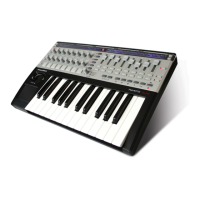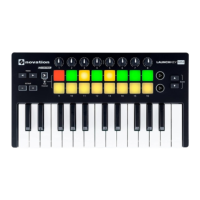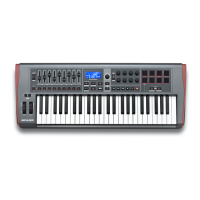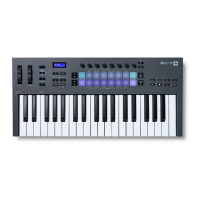19
RE3: Not used.
RE4: Portamento Time
Displayed as: PortTime
Initial value: Off
Range of adjustment: Off, 1 to 127
With Portamento active, notes played sequentially glide from one to the next, rather than
immediately jumping to the desired note pitch. The synth remembers the last note played
and the glide will start from that note even after the key has been released. The Porta-
mento Time is the duration of the glide, and a value of 70 equates to approximately 1
second. Portamento is primarily intended for use in a mono Mode (see RE5 below), where
it is particularly effective. It can also be used in a Poly mode, but its operation can be un-
predictable, particularly when chords are played. Note that Pre-Glide must be set to zero
in order for Portamento to be operative.
RE5: Portamento Mode
Displayed as: PortMode
Initial value: Expo
Range of adjustment: Expo or Linear
This sets the ‘shape’ of the Portamento and Pre-Glide (see RE6 below) transitions from
one note to the next. In Linear mode, the glide alters the pitch evenly between the previous
note and that being played. In Expo mode, the pitch changes more rapidly at first, and then
approaches the ‘target’ note more slowly, i.e., exponentially.
RE6: Pre-Glide
Displayed as: PreGlide
Initial value: 0
Range of adjustment: 0, -12 to +12
Pre-Glide takes priority over Portamento, though it does use the Portamento Time
parameter to set its duration. Pre-Glide is calibrated in semitones, and each note played
will actually begin a on a chromatically-related note up to an octave above (value = +12)
or below (value = -12) the note corresponding to the key pressed, and glide towards the
‘target’ note. This differs from Portamento in that, e.g., two notes played in sequence will
each have their own Pre-Glide, related to the notes played, and there will be no glide
‘between’ the notes.
Although the use of Portamento is not recommended in Poly modes when playing
more than one note at a time, this restriction does not apply to Pre-Glide, which
can be very effective with full chords.
RE7: Polyphony Mode
Displayed as: PolyMode
Initial value: Poly1
Range of adjustment: Mono, MonoAG, Poly1, Poly2, Mono2
As the names imply, three of the possible modes are mono and two are polyphonic.
Mono – this is standard monophonic mode; only one note sounds at a time, and the “last
played” rule applies.
MonoAG – AG stands for Auto-Glide. This is an alternative mono mode, which differs
from Mono in the way Portamento and Pre-Glide work. In Mono mode, Portamento and
Pre-Glide apply both if notes are played separately, or in a legato style (when one note is
played when another is already held down). In MonoAG mode, Portamento and Pre-Glide
only work if the keys are played in a legato style; playing notes separately produces no
glide effect.
Poly1 – in this polyphonic mode successively playing the same note(s) uses separate
voices and the notes are therefore ‘stacked’, so the sound gets louder as more notes are
played. The effect will only be evident on patches with a long amplitude release time.
Poly2 – in this alternative mode, successively playing the same note(s) uses the original
voices, so the volume increase inherent in Poly1 mode is avoided.
Mono 2 – this differs from Mono in the way the Attack phases of the Envelopes are trig-
gered. In Mono mode, when playing Legato style, the envelopes are only triggered once, by
the initial key press. In Mono 2 mode, every key press will re-trigger all the Envelopes.
RE8: Not used
envelopeS
The UltraNova provides a great deal of flexibility in the use of envelopes in sound creation,
based on the familiar ADSR concept.
The ADSR envelope can be most easily visualised by considering the amplitude (volume)
of a note over time. The envelope describing the “lifetime” of a note can be split into four
distinct phases, and adjustments are provided for each of these:
Attack – the time it takes for the note to increase from zero (e.g. when the key is pressed)
to its maximum level. A long attack time produces a “fade-in” effect.
Decay – the time it takes for the note to drop in level from the maximum value reached at
the end of the attack phase to a new level, defined by the Sustain parameter.
Sustain – this is an amplitude value, and represents the volume of the note after the initial
attack and decay phases – i.e., while holding the key down. Setting a low value of Sustain
can give a very short, percussive effect (providing the attack and decay times are short).
Release – This is the time it takes for the note’s volume to drop back to zero after the key is
released. A high value of Release will cause the sound to remain audible (though diminish-
ing in volume) after the key is released.
Although the above discusses ADSR in terms of volume, note that the UltraNova is
equipped with six separate Envelope generators, allowing control of other synth blocks as
well as amplitude – e.g., filters, oscillators, etc.
Pressing the ENVELOPE button [15] opens the Envelope Menu, which has two pages for
each envelope. One of the SELECT buttons and one of the PAGE buttons will be illumi-
nated, indicating that more than one envelope is available to be controlled and that further
menu pages are available. A total of 16 parameters per envelope is displayed for adjust-
ment, eight per Page. Note that the last parameter on Page 2 is common to all envelopes,
and this appears on Page 2 for all envelopes.
Envelope 1 (Amplitude) parameters (Page 1)
Envelope generator 1 controls the ADSR parameters of the notes’ amplitudes.
RE1: Amplitude Attack Time
Displayed as: AmpAtt
Initial value: 2
Range of adjustment: 0 to 127
This parameter sets the note’s attack time. With a value of 0 the note is at its maximum
level immediately the key is pressed; with a value of 127, the note takes over 20 seconds
to reach its maximum level. At the mid-setting (64), the time is approx. 220 ms (provided
Amplitude Attack Slope (Page 2, RE1) has a value of zero).
TIME
KEY "ON" KEY "ON"
PITCH
Portamento Time
TIME
KEY "ON" KEY "ON"
PITCH
Portamento Time
ATTACK DECAY RELEASE
SUSTAIN
TIME
KEY "ON" KEY "OFF"
VOLUME
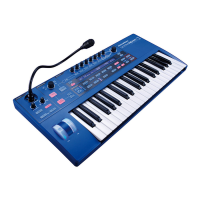
